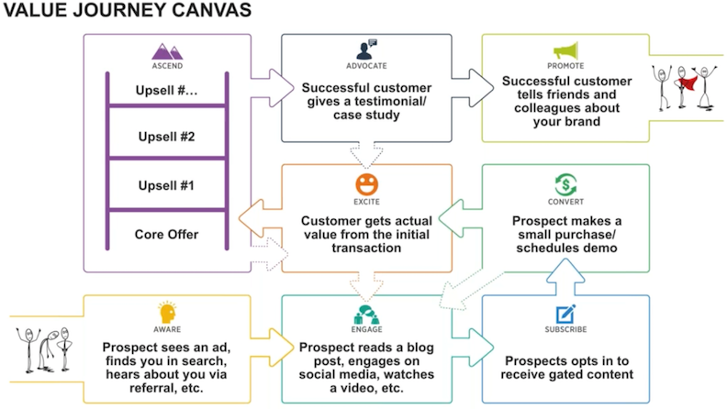Inbound Marketing: Mapping Your Value Journey Canvas

The inbound marketing methodology is certainly helpful, and it's a resource to turn to again and again to understand the most basic steps to use working to turn a stranger into a customer and a promoter.
However, the inbound marketing methodology is a pretty broad overview of the entire process - and it doesn't go particularly deep into using content to grow your brand. One tool that does go deeper into the inbound marketing process and looks at how companies can stay ahead of the curve when it comes to marketing techniques is the Value Journey Canvas.
The Value Journey Canvas
The main goal of the inbound marketing methodology is to show companies how they can harness their inbound efforts to attract strangers and turn them into happy paying customers. The Value Journey Canvas goes a step beyond that and helps lead companies on a path that turns their customers into "rabid buyers and raving super fans." The Value Journey Canvas is built upon the 12 Stages of Intimacy - or the 12 Steps that people go through when they are getting to know other people, building trust and deciding if they should make a commitment - or not.
The Value Journey Canvas incorporates 8 specific steps marketers must take to grow their business and keep customers happy.
Image Source: Digital Marketer
These steps include:
- Aware: A potential customer learns about your company or brand. This can happen via your website, social media and more.
- Engagement: The lead begins to interact with the content your company has on the Internet. They may read one of your blogs or watch a video.
- Subscribe: Once a potential customer has decided they like your content, they decide to subscribe to it. This means that you now have real contact information from them that you can use to start nurturing them as a lead.
- Convert: During the convert phase, a lead spends time engaging with your company, and they show that they're interested in buying.
- Excite: A lead gets excited about something they might want to purchase. If they don't get excited, they may take several steps backward in their customer journey. Then, a company will have to work to excited them further to ensure they still want to become a paying customer.
- Ascend: During the phase, a lead has indicated that they are excited to work with you. In order to further entice them to become a customer of your company, you can offer them something beyond what they were initially interested in. This can be an additional product, another service or an add-on. This add-on ensures that you get the most value from them possible.
- Advocate: Once your lead has converted and become a paying customer, they have (hopefully) built a positive association with your brand. A company can then reach out to the customer and get feedback from them, which can be used in case studies and for testimonials. This is the honeymoon phase for the customer: take advantage of their delight in your brand to turn them into a brand advocate and collect some marketing collateral from them.
- Promote: During this phase, a happy customer will do the promotional work on their own. Customers will recommend your product or service to friends or family members, and they will market your company for free! To encourage promotion during this phase, you can do things like set up a referral program or affiliate program, which encourages them to actively spread the word about your brand to other people.
ICYMI:
Part I: What is Inbound Marketing?
Part II: Inbound Marketing vs. Content Marketing: What's the Difference?
Part III: Inbound Marketing Methodology and Process
Part IV: Why Should I Use Inbound Marketing? The Data Behind Inbound Success
